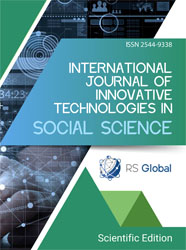LONG TERM CONSEQUENCES OF PRECOCIOUS PUBERTY - EXPLORING HEALTH, METABOLIC, AND PSYCHIATRIC CHALLENGES
Abstract
Introduction and objective:
Precocious puberty (PP) is a condition marked by the premature onset of puberty in children, which can lead to a range of physical, metabolic, and psychological challenges. This review seeks to assess the health implications of precocious puberty and evaluate the treatment options available, with particular emphasis on GnRH analog therapy and the psychological support required for both affected children and their families.
Review methods:
A comprehensive review of studies related to precocious puberty was conducted, focusing on its physical, metabolic, and psychological effects. Research was analyzed on how PP impacts growth, obesity risk, insulin resistance, cardiovascular diseases, and emotional and social challenges in affected children.
Results:
The findings suggest that precocious puberty leads to reduced final height, an increased risk of obesity, insulin resistance, and cardiovascular diseases. Additionally, girls with precocious puberty are at higher risk for developing polycystic ovary syndrome (PCOS), mood disorders, body image issues, and social challenges. GnRH analog therapy has been shown to improve growth outcomes, though the effectiveness of treatment varies depending on the age of initiation and the progression of puberty.
Conclusion:
Precocious puberty is associated with a range of serious health consequences that require a comprehensive treatment approach. Successful management should not only address the medical aspects but also incorporate psychological support and emotional monitoring to improve the overall well-being and quality of life. Early intervention and parental education are essential for improving outcomes, and further research is needed to refine treatment strategies and better understand the long-term effects of this condition.
References
Arcari, A. J., Freire, A. V., Ballerini, M. G., Escobar, M. E., Díaz Marsiglia, Y. M., Bergadá, I., Ropelato, M. G., & Gryngarten, M. G. (2024). Prevalence of Polycystic Ovarian Syndrome in Girls with a History of Idiopathic Central Precocious Puberty. Horm Res Paediatr, 97(2), 134-139. https://doi.org/10.1159/000531264
Banerjee, S., & Bajpai, A. (2023). Precocious Puberty. Indian J Pediatr, 90(6), 582-589. https://doi.org/10.1007/s12098-023-04554-4
Carel, J. C., Lahlou, N., Roger, M., & Chaussain, J. L. (2004). Precocious puberty and statural growth. Hum Reprod Update, 10(2), 135-147. https://doi.org/10.1093/humupd/dmh012
Choi, M. S., & Kim, E. Y. (2016). Body image and depression in girls with idiopathic precocious puberty treated with gonadotropin-releasing hormone analogue. Ann Pediatr Endocrinol Metab, 21(3), 155-160. https://doi.org/10.6065/apem.2016.21.3.155
Çoban Ö, G., Bedel, A., Önder, A., Adanır, A. S., Tuhan, H., & Parlak, M. (2021). Psychiatric disorders, peer-victimization, and quality of life in girls with central precocious puberty. J Psychosom Res, 143, 110401. https://doi.org/10.1016/j.jpsychores.2021.110401
Donbaloglu, Z., & Bostan, R. (2024). Assessing Psychiatric Evaluations in Premature Thelarche and Idiopathic Central Precocious Puberty Cases: Exploring Depression, Anxiety, Quality of Life, and Coping Challenges. Cureus, 16(8), e68123. https://doi.org/10.7759/cureus.68123
Fuqua, J. S. (2013). Treatment and Outcomes of Precocious Puberty: An Update. The Journal of Clinical Endocrinology & Metabolism, 98(6), 2198-2207. https://doi.org/10.1210/jc.2013-1024
Huang, H., Liu, L., Su, S., & Xie, D. (2021). Self-consciousness and depression in precocious pubertal children. J Int Med Res, 49(5), 3000605211020227. https://doi.org/10.1177/03000605211020227
Jang, H. J., Kwak, M. J., Kim, Y. M., Choi, S. H., Park, K. H., Yoo, H. W., Park, S. J., Jo, Y. H., & Jo, H. Y. (2023). Adult height in girls with central precocious puberty without gonadotropin-releasing hormone agonist treatment: a retrospective case-control study. J Yeungnam Med Sci, 40(Suppl), S81-s86. https://doi.org/10.12701/jyms.2023.00801
Jiang, M., Gao, Y., Wang, K., & Huang, L. (2023). Lipid profile in girls with precocious puberty: a systematic review and meta-analysis. BMC Endocr Disord, 23(1), 225. https://doi.org/10.1186/s12902-023-01470-8
Lee, J., Lee, S. I., Lee, Y. M., & Hong, Y. H. (2023). Prevalence of Attention Deficit Hyperactivity Disorder in Girls With Central Precocious Puberty. J Atten Disord, 27(13), 1460-1466. https://doi.org/10.1177/10870547231180116
Mercader-Yus, E., Neipp-López, M. C., Gómez-Méndez, P., Vargas-Torcal, F., Gelves-Ospina, M., Puerta-Morales, L., León-Jacobus, A., Cantillo-Pacheco, K., & Mancera-Sarmiento, M. (2018). Anxiety, Self-esteem and Body Image in Girls with Precocious Puberty. Rev Colomb Psiquiatr (Engl Ed), 47(4), 229-236. https://doi.org/10.1016/j.rcp.2017.05.013 (Ansiedad, autoestima e imagen corporal en niñas con diagnóstico de pubertad precoz.)
Neely, E. K., & Crossen, S. S. (2014). Precocious puberty. Curr Opin Obstet Gynecol, 26(5), 332-338. https://doi.org/10.1097/gco.0000000000000099
Ostrowska, A., & Skrzypczyk, P. (2022). Monogenic hypertension. Pol Merkur Lekarski, 50(297), 198-201.
Soliman, A. T., Alaaraj, N., De Sanctis, V., Hamed, N., Alyafei, F., & Ahmed, S. (2023). Long-term health consequences of central precocious/early puberty (CPP) and treatment with Gn-RH analogue: a short update. Acta Biomed, 94(6), e2023222. https://doi.org/10.23750/abm.v94i6.15316
Temelturk, R. D., Ilcioglu Ekici, G., Beberoglu, M., Siklar, Z., & Kilic, B. G. (2021). Managing precocious puberty: A necessity for psychiatric evaluation. Asian J Psychiatr, 58, 102617. https://doi.org/10.1016/j.ajp.2021.102617
Turan Miral, M., & Hotun Sahin, N. (2022). Psychosocial adaptation to precocious puberty: A nursing support program. J Child Adolesc Psychiatr Nurs, 35(3), 285-294. https://doi.org/10.1111/jcap.12376
Zhang, Y., Ni, J., Zhang, L., Yu, T., Li, X., Xue, P., Liu, Y., Gao, B., Xue, X., Kong, H., & Liu, S. (2022). The prevalence of precocious puberty among children in Qufu City, Shandong Province, China, a population-based study [Original Research]. Frontiers in Endocrinology, 13. https://doi.org/10.3389/fendo.2022.910119
Views:
379
Downloads:
106
Copyright (c) 2024 Justyna Popczyńska, Agnieszka Raczyńska, Natalia Pacocha, Oliwia Krzemień, Kinga Kosiec, Jakub Jędrychowski, Natalia Karpowicz, Julia Kaszucka, Małgorzata Krzyżanowska, Marta Zgierska

This work is licensed under a Creative Commons Attribution 4.0 International License.
All articles are published in open-access and licensed under a Creative Commons Attribution 4.0 International License (CC BY 4.0). Hence, authors retain copyright to the content of the articles.
CC BY 4.0 License allows content to be copied, adapted, displayed, distributed, re-published or otherwise re-used for any purpose including for adaptation and commercial use provided the content is attributed.











